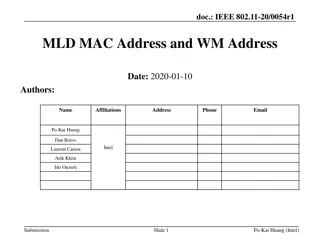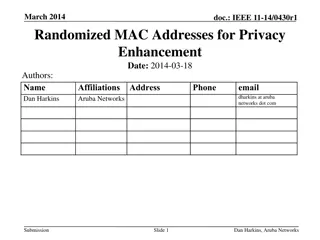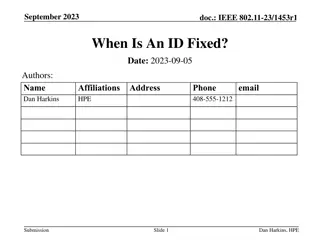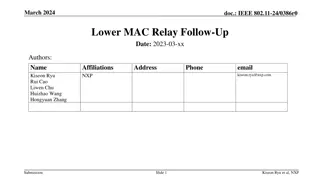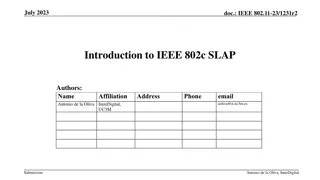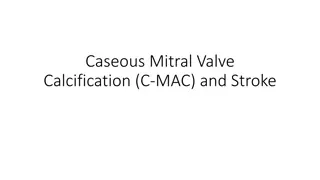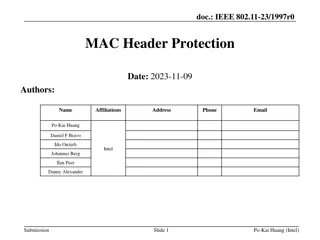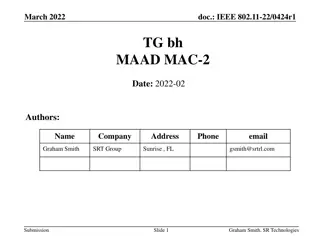Local MAC Address Assignment Protocol (LAAP) and 802.1CQ
The Local MAC Address Assignment Protocol (LAAP) in conjunction with 802.1CQ specifies protocols and procedures for locally unique assignment of MAC addresses in IEEE 802 networks. LAAP operates in two modes - Server Mode and Peer-to-Peer Mode, ensuring efficient allocation of MAC addresses while avoiding conflicts and excessive multicast traffic. The Server Mode involves hosts requesting MAC addresses from a central server, while the Peer-to-Peer Mode allows hosts to claim addresses directly. LAAP aims to support server assignment, peer-to-peer claim assignment, and lightweight protocols to streamline the address assignment process. The protocol is designed to be efficient and scalable, with mechanisms to prevent address conflicts and minimize multicast packets.
Download Presentation

Please find below an Image/Link to download the presentation.
The content on the website is provided AS IS for your information and personal use only. It may not be sold, licensed, or shared on other websites without obtaining consent from the author.If you encounter any issues during the download, it is possible that the publisher has removed the file from their server.
You are allowed to download the files provided on this website for personal or commercial use, subject to the condition that they are used lawfully. All files are the property of their respective owners.
The content on the website is provided AS IS for your information and personal use only. It may not be sold, licensed, or shared on other websites without obtaining consent from the author.
E N D
Presentation Transcript
h Local MAC Address Assignment Protocol(LAAP) -- Thought on 802.1CQ Ting Ao(ZTE) ao.ting@zte.com.cn
Content Previous Arts Basic Requirements for LAAP Two modes in LAAP Server Mode Peer-to-Peer Mode
Prior Arts 802.1CQ PAR&CSD: This standard specifies protocols, procedures, and management objects for locally-unique assignment of 48-bit and 64-bit addresses in IEEE 802 networks. Peer-to-peer address claiming and address server capabilities are specified. http://www.ieee802.org/1/files/public/docs2015/dcb-thaler-1CQ-par-local-address-prot-1115-v0.pdf http://www.ieee802.org/1/files/public/docs2015/dcb-thaler-1CQ-csd-local-address-prot-1115.pdf 802.1CQ Objective: Allow for acquiring multiple addresses Allow for edge bridge / access point proxy http://www.ieee802.org/1/files/public/docs2016/cq-thaler-objectives-1116.pdf Assignment and Validation of Unicast Address 802 should have a single validation protocol as well as assignment protocols. http://www.ieee802.org/1/files/public/docs2016/cq-cas-assignment-and-validation-0316-v00.pptx Structured MAC address assignment with Server Assign structured MAC address hierarchically http://www.ieee802.org/1/files/public/docs2016/cq-ao-local-address-assignment-1116-v00.pptx
Requirements on LAAP LAAP: Local MAC Address Assignment Protocol Basic requirements: Support server assignment and peer-to-peer claim assignment* Allow proxy for fast assignment* It should be a lightweight protocol Avoid addresses conflict Avoid too many multicast packets and avoid loop
Server Mode Principle: Every Host sends MAC Address Request Message to ask for MAC address . Server sends MAC Address Response Message to assign MAC address to the Host. To make sure that the Request Message and Response Message is one-to-one relationship, there should be a Message ID in Request Message and Respond Message. Bridge in the network forward the Request Message to Server, and then forward the Response Message to the Host according to the Message ID. Some Bridges can play as a Proxy to request MAC address block first, so that once it get Request Message, the Proxy can respond instead of Server .
Message Content Message Type MAC Address Request Message MAC Address Respond Message Message ID Identify each message 60 bits/80 bits:48/64 bits MAC address+ 16 bits random number MAC address block MAC address starting address Quantity: number of MAC addresses in the block
Scenarios on Server mode-1 H(Host) send Request Message with Message ID and address number B(Bridge) save the mapping information of Message ID and ingress port, and forward the Request Message to the Server S(Server) get the Request Message and assign a MAC address block in Response Message. The Response Message has the same Message ID with corresponding Request Message. B forward Response Message back to the Host according to the mapping information Server 3 B1 B2 2 4 B22 B21(P21) B11 B12 1 H 1 H 2 H 3 H 4 H 5 H 6 H 7 H 8
Scenarios on Server mode-2 B(Bridge) as a Proxy send Request Message to ask a MAC address block as a minor MAC address resource S(Server) assign some MAC address to B first H(Host) send Request Message to get MAC addresses B(Bridge) as a proxy send Response Message instead of Server with assigned MAC address. Server 2 B1 B2 1 4 B22 B21(P21) B11(P11) B12 3 H 1 H 2 H 3 H 4 H 5 H 6 H 7 H 8 Note: Bridges as Server Proxy can be hierarchical.
Peer-to-Peer Mode Principle: Every Host sends a Register Message to claim its MAC address Every Requester sends a Declare Message to confirm its MAC address if there is no Conflict Message received An ID must be included to differentiate every request no matter it s a Register Message, Conflict Message or Declare Message. A Proxy entity is involved to make the claim action be more efficient.
Message Content Message Type Register Message: To register MAC address block in the network Conflict Message: To inform the conflict Declare Message: To declare MAC address block in the network. Once declared, the MAC addresses can be used by the declarant. Message ID Identify each message 60 bits/80 bits:48/64 bits MAC address+ 16 bits random number MAC address block MAC address starting address Quantity: number of MAC addresses in the block
Scenarios on Peer-to-Peer mode-1 T(Talker) send Register Message with Message ID and MAC address block B(Bridge) save the mapping information of Message ID and ingress port, and forward the Register Message to other ports except ingress port L(Listener) get the Register Message and check the MAC address block if there is a conflict. If yes, L send out a Conflict message with the same Message ID in the Register Message. If not, terminate the Register Message. Bridge forward the Conflict Message according to the mapping information. If T get the Conflict Message and start a new registration cycle. If not, T send Declare Message to the network B 2 4 B B B 1 5 3 T L L
Scenarios on Peer-to-Peer mode-2 T(Talker) send Register Message with Message ID and MAC address block B(Bridge) save the mapping information of Message ID and ingress port, and forward the Register Message to other ports except ingress port P(Proxy) check the MAC address block in the Register Message whether there is a conflict. If yes, send out Conflict Message back to T. If not, forward the Register Message to other ports. If T get the Conflict Message, it starts a new registration cycle. If not, T send Declare Message to the network P record the MAC address block to be used according to the information in Declare Message. 3 B(P) 5 2 B B B 1 4 T L L
Scenarios on Peer-to-Peer mode-3 T(Talker) send Register Message with Message ID and MAC address block B(Bridge) save the mapping information of Message ID and ingress port, and forward the Register Message to the Server S(Server) not only can assign MAC address , but also can check the MAC address block in the Register Message whether there is a conflict. If yes, send out Conflict Message back to T. If T get the Conflict Message then start a new registration cycle. If not, T send Declare Message to the network S record the MAC address block to be used according to the information in Declare Message., and will not assign these MAC addresses to other Requester. 3 S 5 2 B B B 1 4 T L L
Some thought to be considered What should LAAP based? MRP, LRP? LLDP, VDP? Or as a new protocol Multicast address assignment will be considered VM migration may lead to issues to the protocol No matter MAC Address Request Message , MAC Address Register Message or MAC Address Declare Message, they are multicast packets, and loop avoidance should be considered. Coordination need to be considered when multiple assignment protocols co-exist.





